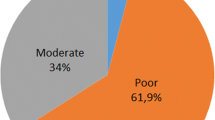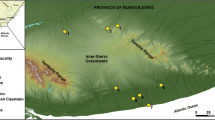Abstract
Archaeological research in the Palpa valleys, southern coast of Peru, has revealed the existence of a long cultural process, during which the site of Pernil Alto had an important role in the process of settlement in the Palpa valleys during the Mid-Archaic Period (3600–3000 BC) and the Initial Period (1500–800 BC). In this paper, we present the preliminary results of archaeozoological studies of animal bones excavated in Pernil Alto. We identify the animal taxa that the Pernil Alto human group had access to and how they used them over time during the Mid-Archaic Period and the Initial Period. The description and methodological analysis of each category used to classify 1361 bone fragments is discussed. The sample studied indicates that during the Mid-Archaic Period, animal use was varied, while during the Initial Period the primary emphasis was on the use of camelids (Camelidae), with continued use of other protein sources including guinea pigs (Caviidae) and deer (Cervidae), among others.
Access this chapter
Tax calculation will be finalised at checkout
Purchases are for personal use only
Similar content being viewed by others
References
Altamirano Enciso AJ (1983) Guía osteológica de cérvidos andinos, Serie de Investigaciones, vol 6. Gabinete de Arqueología, Colegio Real, Universidad Nacional Mayor de San Marcos, Lima
Angulo E, Cardoza CR (2009) Arqueozoología: informe del análisis de los restos óseo-animal del sitio de Cashamarca (Tarma–Junín). In: Calderón Lazo MG (ed) Cashamarca: Su ubicación dentro del proceso histórico del Antiguo Perú. Fondo Editorial Cementos Lima, Lima, pp 132–147
Cardoza CR, Angulo E, Wittmann A (n.d.) Manuales osteológicos I. Familia Camelidae. Unpublished manuscript
Chaix L, Meniel P (2001) Archéozoologie. Les animaux et l’archéologie. Editions Errance, Paris
Donnan CB (1964) An early house in Chilca, Peru. Am Antiq 30:137–144
Eitel B, Mächtle B (2009) Man and environment in the eastern Atacama Desert (Southern Peru): Holocene climate changes and their impact on pre-Columbian cultures. In: Reindel M, Wagner G (eds) New technologies for archaeology: multidisciplinary investigations in Palpa and Nasca, Peru. Springer, New York, pp 17–37
Eitel B, Hecht S, Mächtle B et al (2005) Geoarchaeological evidence from desert loess in the Nazca-Palpa Region, Southern Peru: paleoenviromental changes and their impact on pre-Columbian cultures. Archaeometry 47(1):137–158
Engel FA (1957) Early sites in the Pisco Valley of Peru: Tambo Colorado. Am Antiq 23(1):34–45
Engel FA (1966) Geografía humana prehistórica y agricultura precolombina de la Quebrada de Chilca. Universidad Nacional Agraria La Molina, Lima
Engel FA (1980) Prehistoric Andean ecology. Man, settlement and environment in the Andes, vol. 1: paloma. Distributed by Humanities Press for the Department of Anthropology, Hunter College, City University of New York, New York
Engel FA (1981) Prehistoric Andean ecology. Man, settlement and environment in the Andes, vol. 2: the deep south. Distributed by Humanities Press for the Department of Anthropology, Hunter College, City University of New York, New York
Engel FA (1987) De las begonias al maíz. Vida y producción en el Perú antiguo. Universidad Nacional Agraria La Molina, Lima
Engel FA (1988) Ecología prehistórica andina. El hombre, su establecimiento y el hombre de los Andes. La vida en tierras áridas y semiáridas. Chilca Pueblo I. Implementos de hueso. C.I.Z.A, Lima
Engel FA (1991) Un Desierto en Tiempos Prehispánicos: Río Pisco, Paracas, Río Ica. Centro de Investigación de Zonas Áridas “CIZA”, Universidad Nacional Agraria La Molina, Lima
García R, Pinilla J (1995) Aproximación a una secuencia de fases con cerámica temprana de la región de Paracas. J Steward Anthropol Soc 23(1–2):43–81
Gorbahn H (2013) El sitio de Pernil Alto del Arcaico Medio en el sur del Perú: comienzo de horticultura y sedentarismo en condiciones del Holoceno Medio. Diálogo Andino 41:61–82
Isla J (2010) Perspectivas sobre el proceso cultural en los valles de Palpa, costa sur del Perú. In: Valle L (ed) Arqueología y Desarrollo. Experiencias y Posibilidades en el Perú. Ediciones SIAN, Trujillo, Peru, pp 15–52
Julien M (1985) L’industrie osseux. Quatrième Parti, Chapitre II. In: Lavallee D, Julien M, Wheeler J, Karlin C (eds) Telarmachay. Chasseurs Préhistoriques des Andes. Tome XXVIII des Travaux de l’Institut Français d’Etudes Andines, Paris, pp 215–241
Lanning, EP (1960) Chronological and cultural relationships of early pottery styles in ancient Peru. Dissertation, University of California, Berkeley
Mengoni Goñalons GL (2006–2010) Zooarqueología en la práctica: algunos temas metodológicos. XAMA 19–23:83–113. Mendoza, Argentina
Pozzi-Escot D, Cardoza CR (1986) El consumo de camélidos entre el Formativo y Wari, en Ayacucho. Instituto Andino de Estudios Arqueológicos (INDEA)/Universidad Nacional San Cristóbal de Huamanga, Ayacucho, Peru
Quilter J (1989) Life and death at Paloma: society and mortuary practices in a preceramic Peruvian village. University of Iowa Press, Iowa City
Reindel M (2009) Life at the edge of the desert–archaeological reconstruction of the settlement history in the valleys of Palpa, Peru. In: Reindel M, Wagner G (eds) New technologies for archaeology: multidisciplinary investigations in Palpa and Nasca, Peru. Springer, Berlin, pp 439–461
Reindel M, Isla J (2006) Evidencias de culturas tempranas de los valles de Palpa, costa sur del Perú. Boletín de Arqueología 10:237–283. Pontificia Universidad Católica del Perú, Lima
Reindel M, Isla J (2009) El Período Inicial en Pernil Alto, Palpa, costa sur del Perú. Boletín de Arqueología 13:259–288. Pontificia Universidad Católica del Perú, Lima
Reindel M, Isla J (2013) Cambio climático y patrones de asentamiento en la vertiente occidental de los Andes del sur del Perú. Diálogo Andino (41):83–99
Riddell F A, Valdez LM (1987–1988) Hacha y la ocupación temprana del valle de Acarí. Gaceta Arqueológica Andina 16:6–10. Instituto Andino de Estudios Arqueológicos (INDEA), Lima
Robinson RW (1994) Recent excavations at Hacha in the Acarí Valley, Peru. Andean Past 4:9–37
Rowe JH (1963) Urban settlements in ancient Peru. Ñawpa Pacha 1:1–27
Sandweiss DH (2014) Early coastal South America. In: Renfrew C, Bahn P (eds) Cambridge world prehistory. University of Cambridge Press, Cambridge, pp 1058–1074
Sandweiss DH, Rademaker KM (2013) El poblamiento del sur peruano: costa y sierra. Boletín de Arqueología 15:275–294. Pontificia Universidad Católica del Perú, Lima
Unkel I, Reindel M, Gorbahn H et al (2012) A comprehensive numerical chronology for the pre-Columbian cultures of the Palpa valleys, south coast of Peru. J Archaeol Sci 39:2294–2303
Valdéz LM (1988) Los camélidos en la subsistencia Nasca: el caso de Kawachi. Boletín de Lima 57:31–35
Wheeler J (1985) De la Chasses à l’élevage. Deuxième Partie. In: Lavallee D, Julien M, Wheeler J, Karlin C (eds) Telarmachay. Chasseurs Préhistoriques des Andes. Tome XXVIII des Travaux de l’Institut Français d’Etudes Andines, Paris
Author information
Authors and Affiliations
Corresponding author
Editor information
Editors and Affiliations
Rights and permissions
Copyright information
© 2017 Springer International Publishing AG
About this chapter
Cite this chapter
Cardoza, C.R., Isla, J., Reindel, M., Angulo, E., Gorbahn, H., Jiménez, L.W. (2017). Use of Animals During the Mid-Archaic and the Initial Period in Pernil Alto: A Site in the Palpa Valleys, Southern Coast of Peru. In: Mondini, M., Muñoz, A., Fernández, P. (eds) Zooarchaeology in the Neotropics. Springer, Cham. https://doi.org/10.1007/978-3-319-57328-1_7
Download citation
DOI: https://doi.org/10.1007/978-3-319-57328-1_7
Published:
Publisher Name: Springer, Cham
Print ISBN: 978-3-319-57326-7
Online ISBN: 978-3-319-57328-1
eBook Packages: Earth and Environmental ScienceEarth and Environmental Science (R0)




